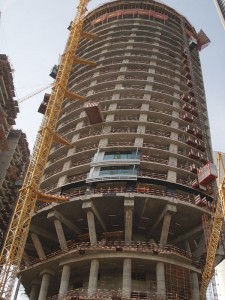UAE DeSimone Consulting Engineers was an Outstanding Award Winner for the Regent Emirate Pearl Hotel project in the 2012 NCSEA Annual Excellence in Structural Engineering awards program (Category – International Structures over $100M).
The iconic Regent Emirates Pearl development will rise and twist 255 meters (840 feet) above its calm turquoise ocean front, claiming its spot in the Abu Dhabi skyline. The mixed-use AED 1.0B ($287M) complex is located amidst palaces and high profile skyscrapers on the Corniche Street of Abu Dhabi in the United Arab Emirates. The vast plot area of 13,600 square meters (146,500 square feet) provides top rate views of Capital City, private islands and yachts along with the luxurious Emirates Palace.
 The Pearl’s signature feature is the 45-story twisting elliptical floor plan, and columns which contains 60 luxury serviced apartments occupying levels 1 thru 10 and a 5-star hotel with 437 keys including presidential and royal suites occupying levels 11 thru Roof. The expansive podium area includes five levels of restaurants, retail areas, spas, swimming pools, a gym and more, with another 5 levels of underground parking. The total project build up area includes 55 stories and 130,600 square meters (1.4 million square feet).
The Pearl’s signature feature is the 45-story twisting elliptical floor plan, and columns which contains 60 luxury serviced apartments occupying levels 1 thru 10 and a 5-star hotel with 437 keys including presidential and royal suites occupying levels 11 thru Roof. The expansive podium area includes five levels of restaurants, retail areas, spas, swimming pools, a gym and more, with another 5 levels of underground parking. The total project build up area includes 55 stories and 130,600 square meters (1.4 million square feet).
The main structural challenge was to appropriately model, analyze and design the complicated twisting shape of the tower. The perimeter tower columns are inclined 7 degrees vertically and “shift” 48 centimeters (19 inches) each level in the circumferential direction, with a total of 21.60 meters (70.8 feet) from bottom to top. In plan, each floor rotates 0.56 degrees each level with a total of 25 degrees of total rotation from Level 1 to the Roof.
The sloping columns cause the building to rotate at each level, therefore inducing a torsional force in the elliptical concrete core wall, with the force accumulating over the height of the building. DeSimone carefully studied and analyzed the effects of the torsional force, and formulated a structurally innovative solution to relieve the torsion from the core. The perimeter tower columns were strategically located to transfer at Level 27 and Level 1 in order the help relieve the torsion from the core. The inclined concrete tower column transfers were designed to reverse the twist by transferring the column gravity loading directly into the core wall in the opposite direction of the torsional force, and therefore reversing the force in the core wall.
The tower columns and transfers played a two part structural role in the stability of the building. The first role, as described above, is to help alleviate the twist on the core wall; the second is to act as part of the lateral force resisting system as an outrigger to help the core wall resist the lateral loads. The perimeter tower columns range from 400 x 1600 millimeters (16 x 63 inches) at the top to 600 x 1600 millimeters (24 x 63 inches) at Level 1. From Podium Roof to the raft, the tower columns transfer to 1325-millimeter (53-inch) diameter, circular.
The structural gravity framing system of the typical tower floors is composed of Post Tensioned slabs supported by concrete perimeter columns and a central elliptical core wall. The 27 centimeter (10.5 inch) PT-concrete C50 (7,200 psi) flat plate slabs span more than 10.5 meters (35.0 feet) from the core wall to the perimeter tower columns. The flat plate design reduced the construction time significantly. This structural system concentrated the gravity loads into the core wall, to help reduce the reinforcing of the core wall due to wind and seismic forces. Also, this system helps minimize the load to the 16 perimeter tower columns that transfers at Level 1 to 1325-millimeter (53-inch) diameter, circular.
Since the slab and core wall are elliptical in plan, a slip form was key to the success of the speed of construction and the project as a whole. This factor, and many other strategic components, helped with the delivery of the project below budget and construction schedule.
The Podium Levels consists of a cast-in-place concrete slab and beam gravity system. The Architect’s façade requirements at the Lobby Level prevented the Podium Level North and South perimeter columns to continue past Podium 1. In order to facilitate the Architect’s needs, another unique and innovative structural solution was provided. Steel hangers from Podium 1 to 3 were designed and installed as an attractive structural solution. The hangers are supported by a deep Post Tension beam at the Podium Roof where clear height was not a major issue.
The project also has 5 underground parking levels to accommodate the 679 parking spaces required by Abu Dhabi’s DOT. The 20.0-meter (66-foot) deep excavation was unearthed and sealed off using a temporary reinforced concrete diaphragm wall with tie-backs. Since Abu Dhabi is an island with the average water level at ground level, excavating that deep below the surface creates extremely high hydrostatic forces. The diaphragm system provided a water-free environment to apply extensive water proofing and to build the permanent foundation walls. The foundations walls have an average thickness of 375 millimeters (15 inches) and were designed to resist soil and tremendous water pressure.▪
